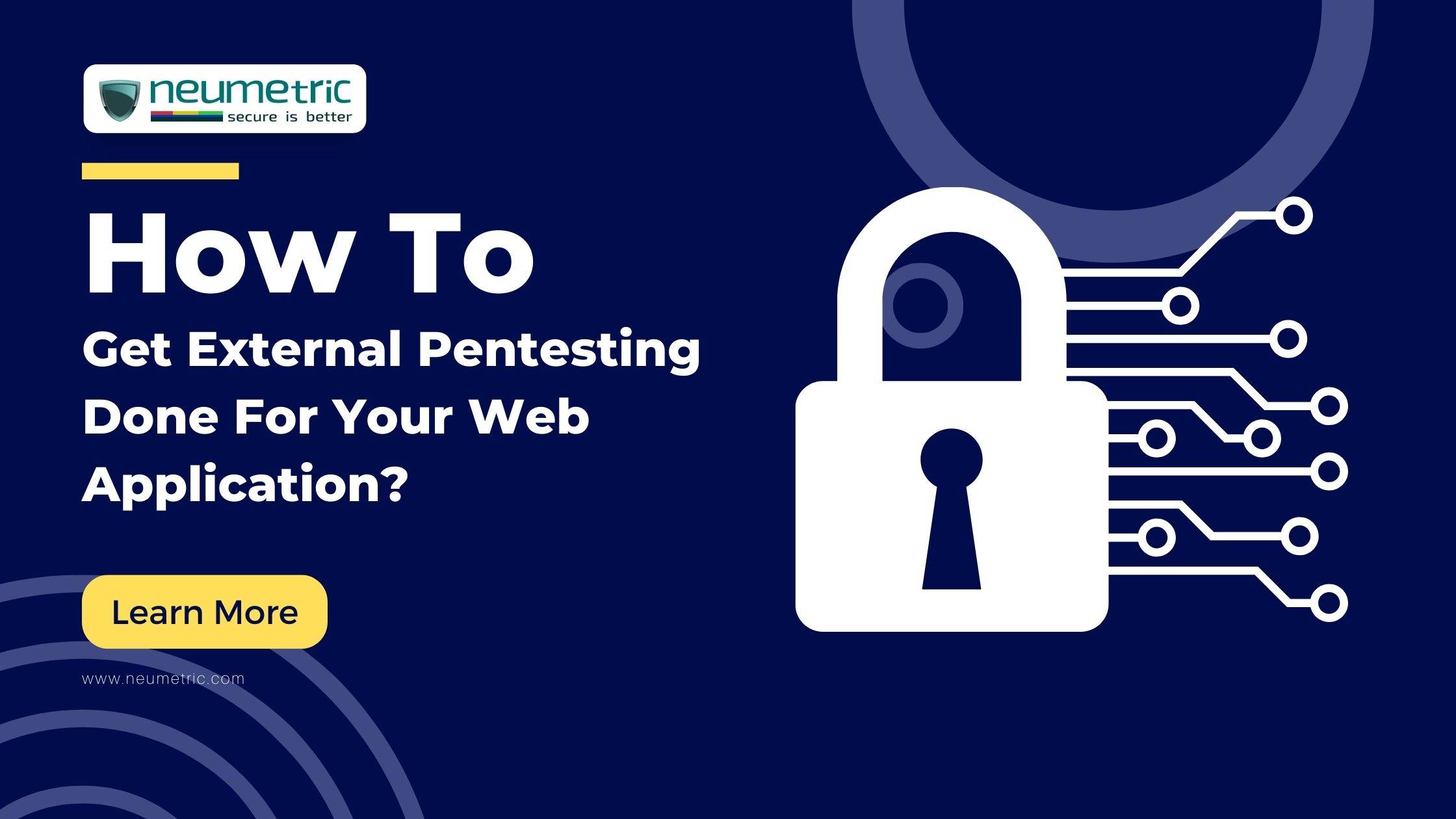Table of Contents
ToggleIntroduction
In a world where every click & tap connects us, the digital realm isn’t all sunshine & rainbows. It’s more like a battleground with unseen adversaries lurking in the shadows. The threat landscape in cyberspace is growing, with hackers becoming increasingly sophisticated. Your web application, your castle, needs a robust defence strategy.
Enter the unsung hero – external penetration testing. It’s not just about checking boxes on a security list; it’s about proactively strengthening your fortress. Ethical hacking, as it’s often called, is like having a friendly mercenary test your defences from the outside. It’s the reality check your web app needs to stand tall against real-world threats.
Now, buckle up because we’re about to dive deep into the world of external pentesting. From understanding the basics to preparing for the battlefield, this article is your guide to fortifying your digital haven. We’ll journey through each crucial step, learn from real-world case studies, explore the challenges, & glimpse into the future trends that will shape the way we defend our web applications.
Understanding External Pentesting
Let’s get the basics straight. External pentesting is like hiring a friendly hacker to simulate real-world attacks on your web app. It’s not just about fixing vulnerabilities; it’s about understanding how a malicious actor might exploit them.
Internal testing is like checking your home’s locks from the inside. External testing, on the other hand, is stepping outside & checking if your windows are secure. It’s about looking at your web app from the perspective of a potential attacker.
Imagine having a castle with a strong drawbridge but a hidden backdoor. If you don’t test from the outside, you might miss that vulnerability. The real-world implication? A potential breach that could have been prevented.
Preparing for External Pentesting
Documentation Review: It’s time to dust off those manuals. Thoroughly reviewing your documentation sets the stage for a successful external pentest. Know your code, know your infrastructure.
Identifying Critical Assets: What are the crown jewels of your digital kingdom? Identifying critical assets ensures that the external pentest focuses on what matters most.
Drawing the battlefield lines is crucial. Defining the scope ensures that the ethical hackers know where to focus their efforts, preventing unintended disruptions. Your defenders need to be as skilled as the attackers. Look for a team with the right qualifications & certifications. Their industry experience is the battlefield wisdom that can make all the difference.
Key Steps in External Pentesting
A. Reconnaissance
Gathering Information about the Target: Ethical hackers are like digital detectives. They gather intel on your web app – understanding its weaknesses, potential vulnerabilities, & the lay of the land.
Identifying Potential Attack Vectors: Where could an attacker potentially strike? Identifying attack vectors is about predicting the enemy’s moves before they make them.
B. Scanning & Enumeration
Identifying Open Ports & Services: Think of open ports as the windows of your castle. Identifying them is crucial to understanding how your web app is exposed.
Enumerating System Details: Ethical hackers delve deeper, mapping out your system details. It’s like creating a blueprint of your castle’s interior.
C. Vulnerability Analysis
Automated Tools vs. Manual Inspection: It’s a combination of high-tech tools & human insight. Automated tools quickly identify common vulnerabilities, while manual inspection uncovers the more intricate ones.
Assessing Deeper Vulnerabilities: This is the part where ethical hackers don their detective hats again. They go beyond the surface, finding vulnerabilities that automated tools might miss.
D. Exploitation
Simulating Real-World Attacks: This is where the ethical hackers put on their black hats – not to cause harm but to simulate real-world attacks. It’s like stress-testing your defences.
Ethical Considerations in Exploitation: It’s a delicate dance. Ethical hackers ensure they don’t disrupt your operations while still testing the resilience of your web app.
Reporting & Analysis
The aftermath of the battle is documented in a comprehensive report. It’s not a bunch of technical jargon; it’s a narrative that tells the story of your web app’s security.
Prioritising Vulnerabilities: Not all vulnerabilities are created equal. Prioritising them helps you focus on fixing the most critical ones first.
Providing Actionable Recommendations: The report isn’t just a list of issues; it’s a guide on how to fortify your defences. Actionable recommendations are the treasure map to a more secure web app.
Fixes are implemented, but are they effective? Re-testing & validation ensure that the vulnerabilities are truly sealed, making your web app a more formidable fortress.
Post-External Pentesting Measures
A. Implementing Recommended Security Measures
It’s not about putting a band-aid on a wound; it’s about implementing robust security measures. This could involve updating software, configuring firewalls, or strengthening access controls.
B. Continuous Monitoring & Improvement
Your web app’s security is not a one-time job. Continuous monitoring ensures that you’re always one step ahead of potential threats. It’s about evolving with the ever-changing digital landscape.
C. Updating Security Policies & Procedures
As the threats evolve, so should your defence strategy. Updating security policies & procedures ensures that your web app is not stuck in the past but is equipped to face future challenges.
Challenges & Considerations
A. Common Challenges in External Pentesting
Every battle has its challenges. In the world of external pentesting, common challenges might include resistance from internal teams, logistical issues, or unexpected disruptions.
B. Addressing Legal & Ethical Concerns
Ethical hacking sometimes walks a thin line. Addressing legal & ethical concerns ensures that the testing process is transparent, legal, & conducted with integrity.
C. Overcoming Resistance within the Organization
Not everyone might be thrilled about ethical hackers poking around. Overcoming internal resistance involves effective communication & showcasing the long-term benefits of external pentesting.
Future Trends in External Pentesting
A. Evolving Threats & the Need for Continuous Testing
The digital battlefield is a dynamic landscape, with threats evolving faster than ever. External pentesting is not a one-and-done affair; it’s an ongoing commitment. As cyber threats become more sophisticated, the need for continuous testing becomes paramount. Think of it as staying ahead of the curve, anticipating the moves of potential adversaries, & fortifying your defences in real-time.
B. Integration of Artificial Intelligence in Penetration Testing
Picture this: an army of intelligent bots working alongside ethical hackers. The integration of artificial intelligence (AI) in penetration testing is not just the future; it’s the present. AI can process vast amounts of data at lightning speed, identifying patterns & vulnerabilities that might escape the human eye. It’s like having a cyber sidekick, enhancing the efficiency & accuracy of the testing process.
C. The Impact of Emerging Technologies on External Pentesting
As technology advances, so does the arsenal of both defenders & attackers. The impact of emerging technologies on external pentesting is profound. From the rise of Internet of Things (IoT) devices to the widespread adoption of cloud computing, understanding how these technologies influence security is crucial. It’s about adapting external pentesting methodologies to the ever-changing tech landscape, ensuring your defences are future-proof.
Conclusion
In the grand scheme of digital security, external pentesting emerges as a hero, not just a sidekick. It’s not about finding vulnerabilities; it’s about fortifying your web application against the ever-evolving threats in cyberspace. The importance of external pentesting lies not only in securing your data but in safeguarding the trust your users place in your digital sanctuary.
Let’s face it – waiting for an attack is like locking the stable door after the horse has bolted. Encouraging a proactive approach to web application security through external pentesting is akin to strengthening your castle walls before the siege. It’s about being a step ahead, anticipating threats, & creating a resilient fortress that can withstand the tests of time.
XI. Additional Resources
A. Recommended Tools & Resources for External Pentesting
Arming yourself with the right tools is half the battle won. From penetration testing frameworks to vulnerability scanners, the world of external pentesting has a plethora of tools at your disposal. Some noteworthy mentions include Metasploit, Burp Suite, & OWASP ZAP. Remember, these tools are your trusted companions in the journey to fortify your digital haven.
B. Further Reading & Learning Opportunities
Knowledge is power, & in the realm of external pentesting, continuous learning is key. Whether you’re a seasoned cybersecurity professional or a curious novice, there’s always room to expand your understanding. Dive into books like “The Web Application Hacker’s Handbook” by Dafydd Stuttard & Marcus Pinto, or explore online courses offered by platforms like Coursera & Udacity. The more you know, the better equipped you are to face the ever-evolving challenges of web application security.
In conclusion, external pentesting is not just a task to check off your security checklist. It’s a strategic initiative, a proactive stance, & a commitment to ensuring your web application remains a fortress impervious to cyber threats. As you embark on this journey, armed with knowledge & the right tools, remember: the best defense is a well-tested one. Stay vigilant, stay secure, & may your digital fortress stand tall against the tides of change.
FAQs:
Why should I bother with external pentesting when my web application already has internal security measures?
External pentesting is like putting your web app through a simulated stress test. While internal security measures are crucial, they’re like locking the doors from the inside. External pentesting, on the other hand, checks for vulnerabilities as if someone’s trying to break in. It’s about seeing your web app from a potential attacker’s viewpoint & fortifying your defences where they meet the outside world.
How often should I conduct external pentesting for my web application, & is it a one-time thing?
Think of external pentesting as a routine health check for your digital castle. The cyber landscape is always changing, & so are the threats. Conducting external pentesting isn’t a one-time deal; it’s an ongoing commitment. As the saying goes, “An ounce of prevention is worth a pound of cure.” Regular testing ensures you’re continuously adapting to emerging threats, making your web app a formidable fortress against potential attacks.
Can’t I just rely on automated tools to secure my web application? Why involve ethical hackers in external pentesting?
Automated tools are like trusty sidekicks, efficient at spotting common vulnerabilities. But, & it’s a big but, they can’t replicate the creativity & intuition of a human hacker. Ethical hackers bring that extra edge – they simulate real-world attacks, think outside the box, & identify nuanced vulnerabilities that automated tools might miss. It’s not just about fixing issues; it’s about fortifying your web app against the unexpected.





